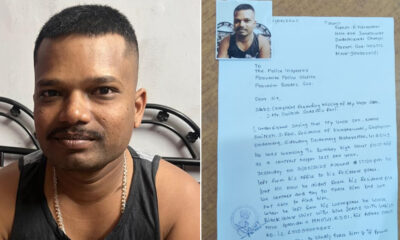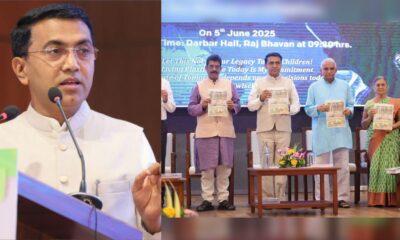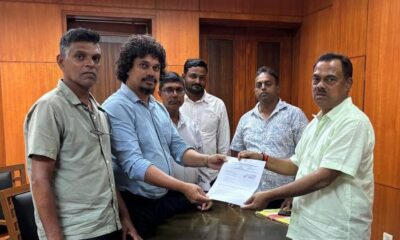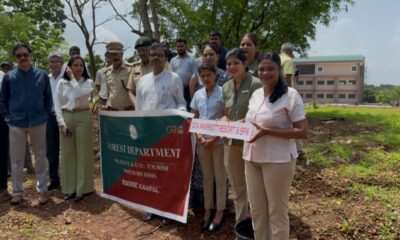General
Mhadei dispute: Crisis in Goa scales up challenges for Chief Minister, puts BJP in tight spot
Published
2 years agoon
By
goaplusnews
The Central Water Commission (CWC), which approved Karnataka’s Detailed Project Report (DPR) for the contentious Kalasa-Bandura water diversion project on December 29, has made the BJP government in neighbouring Goa in tight spot.
The project plans to divert Mhadei/Mandovi river system waters into the Malaprabha reservoir is a huge emotive red flag in Goa.
In the past fortnight, the Goa opposition has vehemently opposed the BJP government’s failure to stand up to its Central leadership or party colleagues in Karnataka. Initially, there were calls for all 40 MLAs and the chief minister to resign to reaffirm Goa’s strong sentiments on the matter. BJP Union Minister of State and Goa MP, Sripad Naik, offered to resign before going quiet on the issue.
After the Mhadei Interstate Water Disputes Tribunal’s August 2018 award, granting Karnataka 13.42 tmc (thousand million cubic feet) for its projects, the state has lost no time in preparing DPRs [including to divert 3.9 tmc (110,435.715 million litres) to the Malaprabha basin].
And as the saffron party in Kakarantaka seeks to woo the poll-bound state, the approval to the DPR for water diversion seems to serve the electoral purpose.
AN ‘APOCALYPSE NOW’ MOMENT?
While it may be viewed as just another knotty inter-state water dispute to the rest of India, in Goa, the Mhadei/Mandovi is considered a lifeline of the state. Every chief minister, including current CM Pramod Sawant, has sworn to protect every last drop of the river Mhadei.
What is it about the river that gets Goans riled up? That any thought of its freshwater being diverted, is viewed as an ‘Apocalypse Now’ moment? Geography has much to do with it.
The Mhadei/Mandovi river basin spans 1580 sq km, nearly half the Goa’s total 3702 sq km area that calculates to 43 per cent of the state’s area. It runs 76 km in north Goa, 78 per cent of the Mhadei’s total 111 km.
It passes through 194 (Goa has 334 villages) of its most populous villages and towns, including the capital, Panjim.
The Mhadei/Mandovi is critical for the region’s water supply, agriculture, fishing, irrigation, navigation and tourism in six of the state’s twelve sub-districts. Religious, cultural and daily practices are also woven around the river.
Nirmala Sawant, president of Mhadei Bachao Andolan (MBA) in Goa, also a multi-term former Congress state President and former minister, spoke on the public angst and said that Goa was treated with great injustice.
“Goa has been treated with great injustice by the Centre, simply because we are small and have just three parliamentary seats, compared to 28 (Lok Sabha seats in Karnataka). But should it be a number game? Goa has just two major rivers – Mandovi and Zuari. Karnataka has 20 rivers,” snapped Nirmala.
Most of Goa’s rivers are salty seawater. In the Mhadei/Mandovi case, salt water enters from the Arabian Sea, occupying 69 per cent of its upstream length in Goa. Therefore, it gets essential to ensure that the remaining length stores the fresh water.
Within the state, there is an inherent awareness that diversions of the Mhadei’s freshwater flows could adversely impact the state. Especially the biodiversity hotspot areas of the thickly forested Western Ghats sub-districts on the east.
The Mhadei runs through and sustains three wildlife sanctuaries and one national park – the Bhagwan Mahavir Wildlife Sanctuary and Mollem National Park, Bondla Wildlife Sanctuary, Mhadei Wildlife Sanctuary, and Salim Ali Bird Sanctuary.
Goa, for this reason, has highlighted the outcome of the Mhadei river diversion as a matter of concern not just for Goa but for the world.
BACKGROUND TO THE DISPUTE
Goa has steadfastly opposed any diversion of Mhadei’s waters outside its basin, 78 per cent of which is in Goa, 18 per cent in Karnataka and 4 per cent in Maharashtra. But over the past two decades, it has complained of being bullied.
Proposals to harness the monsoonal flows of the rain-fed Mhadei first came up around the seventies and eighties, when the upper riparian state of Karnataka sought to generate hydropower from the Mhadei waters. These got pushback from the Union government when Goa was a union territory and later by the governments led by the Congress party.
In the nineties, Karnataka articulated proposals for dams on Mhadei’s feeder streams, which sent alarm bells ringing in the small state. Strategically, Karnataka changed the perception and outplayed Goa when it now presented its water demand as a drinking water requirement.
It asked for the immediate release of 7.56 tmc of its share of the Mhadei/Mandovi waters for the water-scarce regions of Hubli-Dharwad and en-route areas.
Goa argued before the Interstate Water Tribunal that if drinking water is a priority for citizens of Karnataka than irrigation and other uses from water supply schemes, in that case, it would not have to reverse the Mhadei’s flow and hack forests for the same.
Furthermore, the state stressed that the drinking water component of the water demand was small, and the real intention was for irrigation and other purposes. It also pointed out that Goa was being penalised when its neighbour had let many of its own river stretches get polluted from dumping sewage.
It also sought to drain the Mhadei away from Goa and into the Malaprabha basin that was depleted from excessive use in water-intensive cropping like sugarcane.
KARNATAKA’s ARGUMENT
Karnataka’s argument is that its only demand was to have a rightful share of the Mhadei’s fresh waters, much of which was being wasted and drained into the Arabian Sea in Goa.
Rebutting Karnataka’s claim, Goa submitted that besides being stored in several reservoirs in the state for drinking water and irrigation schemes, fresh water sustains the forest sanctuaries and prevents saline ingress further upstream, which would alter the ecosystem.
In April 2000, however, the Vajpayee-led government approved the in-principle diversion of 7.56 TMC to Karnataka for meeting “drinking water” needs after the heightened pressure from the state.
While a BJP government in Goa, under the late Manohar Parrikar, managed to get this approval held off in September 2022. As Karnataka began unilateral work on the ground, Goa’s stance shifted, and Parrikar sought adjudication of the issue as an inter-state water-sharing dispute.
He asked for an Interstate Water Sharing Tribunal to determine flows, water requirements, interstate shares, and closer, alternate sources within existing schemes to meet Karnataka’s water demands.
The Tribunal, constituted in 2010, estimated the Mhadei’s flow to be 188.06 tmc per annum based on earlier CWC reports, which was contested by Goa.
It did not apportion the waters until further data was evaluated in 2048, when the award came up for revision. It, however, permitted use for development activities, granting Karnataka 13.42 tmc, Goa 24 tmc and Maharashtra 1.33 tmc for their projects, conditional to fresh DPRs being drawn up and cleared by the centre’s technical appraisal and the projects garnering other clearances, required by law.
The award was a shocking setback to Goa’s case, but the Parrikar-led government in the state claimed victory to evade political jibes. It wasn’t until the centre granted Karnataka environment clearances that the current BJP dispensation took an all-party delegation to appeal to the Centre to hold off the clearance. Goa has also appealed against the award before the Supreme Court, as has Maharashtra and Karnataka.
FRESH CRISIS FOR GOA
A fresh crisis has erupted in Goa’s fight to retain the Mhadei, but party politics seems to have overshadowed the state’s interest. To Sawant’s embarrassment, the opposition proved there was a DPR prepared and handed to the Goa government in 2020, which means the BJP in Goa remained in the loop but maintained silence.
Goa’s Chief Minister Pramod Sawant claimed the revised 2022 DPR was to be officially given to Goa, but that’s not cutting much ice here. What’s going down now in the public view is that activists, environmentalists, the MBA and civil society have to be vigilant about the state’s long-term interests, as party politics could well sink Goa’s long-term interests.
Moreover, the MBA claims that a tributary of the Mhadei had already been surreptitiously diverted, with one riverbed en route to Goa going completely dry.
CM’s POLITICAL FALL
All the developments have put Chief Minister Pramod Sawant in a tight spot and have left him to face irks of rival contenders. An umbrella organisation of activists and opposition political parties named Save Mhadei Save Goa have placed before Sawant an impossible-to-fulfil ultimatum to take steps to revoke Karnataka’s approved DPRs by January 16.
From initially downplaying the imminent threat and relying on civil society to assist with a signature campaign, the chief minister’s camp has to act with alacrity.
You may like
-


Worker Goes Missing After Leaving Porvorim Post Office
-


CM Dr. Pramod Sawant Unveils Key Environmental Initiatives on World Environment Day 2025; Calls for United Action Against Plastic Pollution
-


Goenchea Raponkarancho Ekvott Meets Fisheries Minister; Seeks Strict Enforcement of Court Ban on LED Fishing and Legal Reforms
-


Goa Marriott Resort Leads World Environment Day with Tree Plantation Drive in Collaboration with Goa University and Forest Department
-


Health Minister Launches “Project Parivartan” to Tackle Infections and Curb Antibiotic Misuse in State Hospitals
-


HDFC Bank Parivartan Launches Awareness Campaign Against Plastic Ahead Of World Environment Day








